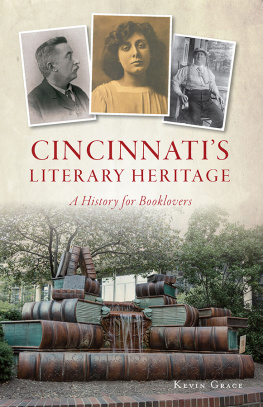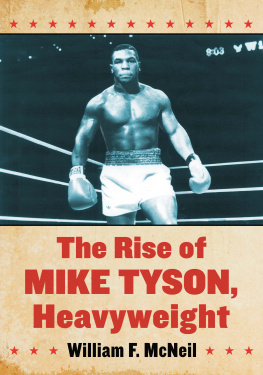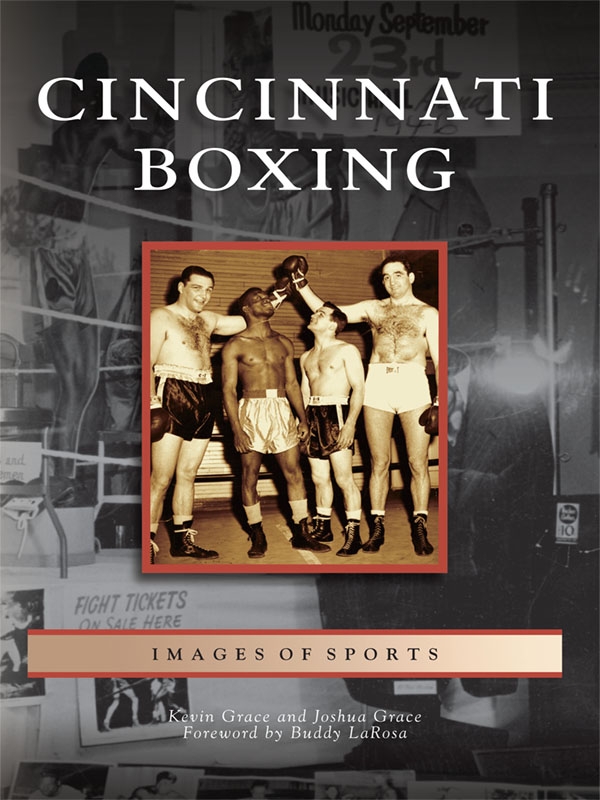For assistance in a wonderful variety of ways, we thank Harry Andreadis; Paul Scrappy Andreadis; Dave Bergin and Pugilistica.com ; Russell Brazzle for the great boxing conversation at work over the years; Debbie Katzler Burns; Larry Burton; Danny DC Calhoun; Patty Castor; Christina Cooper; Mae Corrion of the Jesup Memorial Library of Bar Harbor, Maine; Charlie Curro; Sean Grace; Susan Harris of Lawrenceville, Georgia; Dan Hayes, Martin Horwitz, and Kay Taylor of the Cincinnati Athletic Club; Stuart Hodesh for his extraordinary memories and generous help; Rev. Thomas Kennealy, S.J.; Jack Klumpe; Maria Kreppel; Donald Buddy LaRosa; Tim McCabe of the Xavier University Library; Stephanie McGowan; Reggie Marshall of Mars Jazz Booking Agency; Nanci Mays; George and Alice Russell; Glenn Sample; Bill Schutte; the inestimable Harry Shaffer; Jerome Shochet; and Marsha Wirtz. Unless otherwise noted, all images are from the collections of the authors.
K. G.
J. G.
SELECTED BIBLIOGRAPHY
Castor, Dennis. Freddie Miller, Worlds Featherweight Champion, 19331936 . Video documentary.
Cincinnati Commercial Tribune , 18601930.
Cincinnati Enquirer , 18602006.
Cincinnati Post , 19402006.
Cincinnati Times-Star , 18601958.
Erenberg, Lewis A. The Greatest Fight of Our Generation: Louis vs. Schmeling . New York: Oxford University Press, 2005.
Fried, Ronald K. Corner Men: Great Boxing Trainers . New York: Four Walls, Eight Windows, 1991.
Gorn, Elliot J. The Manly Art: Bare-Knuckle Prize Fighting in America . Ithaca, NY: Cornell University Press, 1986.
Kahn, Roger. A Flame of Pure Fire: Jack Dempsey and the Roaring20s . New York: Harcourt, 1999.
Roberts, James B., and Alexander G. Skutt. The Boxing Register: International Boxing Hall of Fame Official Record Book . Ithaca, NY: McBooks Press, 1996.
Sammons, Jeffrey T. Beyond the Ring: Boxing in American Society . Urbana: University of Illinois Press, 1988.
Sugar, Bert Randolph. Bert Sugar on Boxing: The Best of the Sports Most Notable Writer . New York: The Lyons Press, 2003.
Sullivan, Russell. Rocky Marciano: The Rock of His Times . Urbana: University of Illinois Press, 2002.
Terrill, Marshall. The Flight of the Hawk: The Aaron Pryor Story . Sun Lakes, AZ: Book World/Blue Star, 1996.
www.boxrec.com .
Find more books like this at
www.imagesofamerica.com
Search for your hometown history, your old
stomping grounds, and even your favorite sports team.
FIGHT TOWN
THE 19TH CENTURY
With the completion of the suspension bridge in 1866, Cincinnati continued to grow as an urban center of immigrant settlers, factories, and commercial businesses. In many ways, though, it was still a frontier city. Boxing matches were often fought just beyond the watchful eyes of the law, with sometimes a quick change of venue across the river to the hills and rural areas of northern Kentucky to avoid arrest.
Jem Coyne ventured to Cincinnati in 1869 in search of a prizefight. The English-born Coyne began fighting in 1862, and in Cincinnati, he hoped to land a bout in the match everyone was talking aboutan upcoming fight between two notable pugilists, Mike McCoole and Tom Allen. At Mozart Hall on October 30, Coyne fought an exhibition against Young Newell, drawing blood with a sturdy wipe in the first round. It was reported that master of ceremonies Butt Riley did his duty in a very creditable manner.
Mike McCoole was one tough character. Irish-born, he came to America and worked as a bargeman in Cincinnati on the Ohio River, building up a massive physique along with an irascible nature. His first notable fight was in Louisville in 1858, and since then, he had won the championship belt, 34 inches long and covered with gold and silver plates. After losing the title to Tom Allen in 1868, he was in Cincinnati to challenge Allen and recapture the championship.
In their eventual rematch in Missouri, Tom Allen (right) stopped McCoole to retain the heavyweight championship and held it for a few years until his fellow Englishman, Joe Goss (below), stepped forward with a challenge. Coming to Cincinnati in 1876, the two fighters had to avoid the local authorities who only permitted exhibitions and not out-and-out prizefights. Allen and Goss, with thousands of fans following, headed across the river to Kenton County. On September 1, the match began, but after just 37 minutes and seven rounds, state troops were on the trail and the bout was declared a draw. Six days later, on September 7, they resumed the fight in neighboring Boone County. After 14 rounds, Allen was disqualified when he punched Goss while he was down. Goss was declared the heavyweight champion.

Englishman Jem Mace, the Swaffham Gypsy, and New Zealander Herbert Slade, the Maori, were two bare-knuckled boxers who had success in their own countries and then sought their fistic fortunes in America. Mace began his career in the boxing booths of England where he used either gloves or bare fists, depending on the wishes of his opponent. In 1861, he won the British heavyweight championship. Slade and Mace staged exhibition matches together around the country, journeying to Cincinnati in March 1883 for a demonstration in front of local fight mavens. Mace (left), particularly, was instrumental in promoting the use of boxing gloves and bringing the bare-knuckle era to an end.

Sam the Scaramouch was a Cincinnati tabloid that lampooned virtually everything in American societytemperance and prohibition, politicians and foreign policy, and ethnic groups and the pursuits of everyday leisure. Published in 1885 and 1886, the weekly newspaper took on the growing infatuation with sparring by the gentlemanly classes of Cincinnati, poking fun at the academies of pugilism.
























